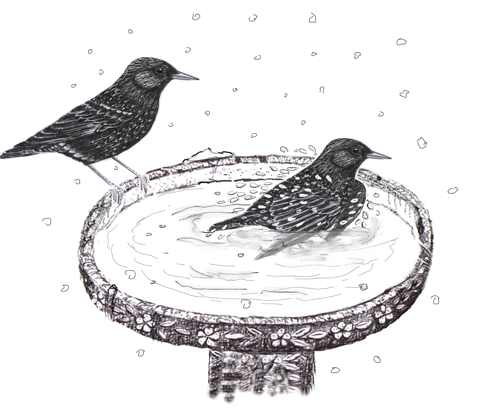
Dear Bird Folks:
Last January, when everything was frozen solid, flocks of starlings would come and splash about in my heated birdbath. When my little cockatiel “Chip” takes a bath, she appears to get soaked down to her pink skin. Why, when the temperature was so awfully cold, wouldn’t the starlings’ water-soaked wings freeze solid? Do starlings have some kind of Brylcreem gland that keeps the water off their feathers?
Anna, Somerville
What kind of glands, Anna,
Brylcreem? How old are you? Where did you get that word? I asked all of my customers if they knew what Brylcreem was and none of them knew. Then one real old guy spoke up and said, “I know what it is.” Even after he told us, we were still confused, but he is such a nice guy we didn’t dare question him. I don’t know his real name but his friends all call him Fonzie. Perhaps you know him.
When you think about it, birds’ feathers are truly a remarkable invention. Feathers give most birds the ability to fly, which puts birds in a league of their own, if you don’t count bats and mosquitoes. Feathers also give each bird species their individuality. Feathers create those amazing patterns that help distinguish a painted bunting from a house sparrow. Or in your case, European starlings from Chip, the pink-skinned cockatiel. Without their feathers, birds would be totally naked and unrecognizable, looking like something packaged by Frank Perdue.
Most importantly, it is the feathers that can insulate birds from just about any hostile environment. From the deep dark frigid reaches of Antarctica, to the blasting heat of Africa, it is those tiny, seemingly weightless feathers that enable birds to survive and thrive. And as you might expect, each species has its own unique set of feathers. Although neither of them can fly, it is a fairly obvious conclusion that penguin feathers are quite different from those of an ostrich.
One thing that feathers are very good at is shedding water. The expression “like water off a duck’s back” applies to just about all birds and not just Fonzie’s hair. Each single feather is made up of, for want of less confusing terms, many miniature feathers, that are linked together by tiny barbs. The barbs hold all the parts of the feather together so tightly that water simply can’t penetrate. The next time you find a feather on the ground, hold it under a running faucet, for as long as you want. The feather, amazingly, will continue to remain dry.
In addition to structural waterproofing, most birds’ feathers are aided by an oil gland (aka Brylcreem gland). The oil may help with waterproofing, but more importantly it keeps the feathers flexible. Brittle feathers don’t hold up to the extremes that birds put them through.
After getting your note Anna, I decided to test these theories. On one of those wicked cold days this past January, when even the thermometers were frozen, I filled up a small pool with water and released a family of pet ducks. Upon seeing the pool, the ducks raced across the yard, dove into the pool and splashed and quacked like they had just won the lottery. When all the craziness had finally calmed down, I picked up one of the ducks for an on-the-spot examination. I found its feathers at every layer to be dry and ice-free. Only the very tips of the outer feathers had a few droplets of ice on them, which the duck immediately preened off.
European starlings are one of the hardiest and most adaptable birds anywhere. Found on every continent, extreme cold and heat doesn’t seem to affect them. Cockatiels on the other hand, with no offense to Chip and his relatives, are far more specialized. There is a reason why flocks of them aren’t seen around Cape Cod and it’s not because they are afraid of possible windmills. Their pretty little feathers aren’t designed for the extreme snow and cold of New England.
Each species has evolved to meet its geographic needs. Some birds are perfect for arid regions, while others are totally at home on an ice floe, while still others seem to be equipped for many climates. As cute as Chip may be, she was not designed for dealing with and bathing in frigid weather. Not unless you first give her a comb-over in Brylcreem. Perhaps you still have a tube of it in the glove box of your Desoto.